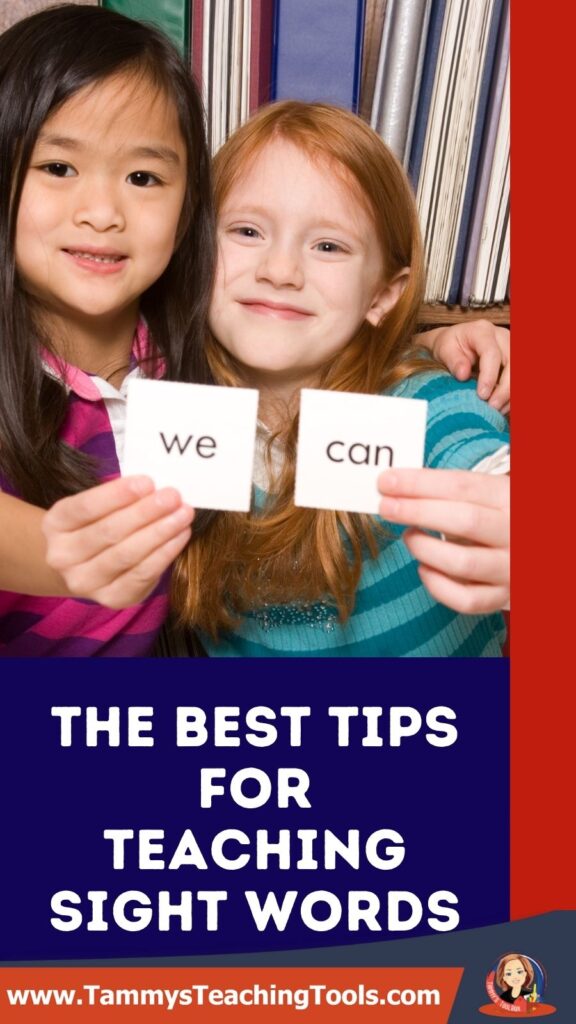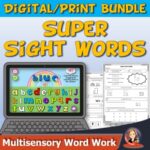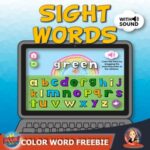The BEST Way to Teach Sight Words
When I was googling “How to teach sight words to struggling readers,” I was sitting in my classroom after a hard day with my hand in a package of chocolate. I was overwhelmed by the reading challenges in my classroom and realized one of the most foundational needs my students have is reading sight words! How the heck am I going to tackle this? It’s going to be fine. In this post, I am going to tell you tips that have helped my students go from reading 40-50% of these instantly recognizable words to 90% and above!
What is a Sight Word?
A sight word is a word read instantly by sight, typically not decodable (cannot be sounded out). According to Orton-Gillingham terms, learned words are what many people call sight words. One may also refer to them as red words (because we STOP and pay attention). This term is often interchanged with the phrase high-frequency words. High-frequency words are words that appear very often. These words include some decodable and some not decodable words. Struggling readers may benefit from multi-sensory reading instruction to gain these missing skills.
The Science Behind Sight Words
Orthographic mapping is important for learning sight words. When we see a word, we break it apart by the sounds we hear in the word and letter patterns that represent those sounds. This process sets the word into our long-term memory. We begin to recognize the word instantly when we see it. We still see all the letters, but we know the word so well that we don’t have to sound it out.
Teach Sight Words to Students of all Ages
Tips
- Use multi-sensory spelling methods in a systematic format. This approach only introduces 1-2 words at a time.
- Take a little time to learn the origin of the learned words and reinforce the reason for its spelling. Use this site for a reference.
- Allow about 10 minutes each day for direct instruction and practice with sight words.
➔ See this post for more tips on using multisensory teaching methods in your classroom.
➔ Also, see A New Model for Teaching High-Frequency Words.
Activities
- Present the word in a variety of formats. Get students ACTIVE with the word. Do this while activating multi-sensory (visual, auditory, kinesthetic, and tactile) techniques.
- Use these questions with a mature audience to guide instruction with each new word. One can adjust or modify these questions for younger students:
- What does the word mean?
- Are there any words that are spelled like the word ___?
- Where does the word come from?
- What words are related to ___? (The group will quickly see how words they didn’t connect before are truly connected.
- Create a word web with the word of choice in the center and write the related words stemming off of it.
- Use tactile opportunities by letting students trace/write the word on paper that is on top of a textured surface. This can be sandpaper, burlap, screen, etc. When finished, they can remove the textured material and use finger to trace the “bumpy” letters. Tracing letters of the word in the air and tapping letters on the arm all activate their muscle memory to remember how to spell that word.
 Many students have difficulty remembering sight words. They may know them one day and forget them the next. It is important to provide a lot of exposure to these words using multiple methods. One of my favorites: combine a tactile activity (like arm tapping) with a chant or song.
Many students have difficulty remembering sight words. They may know them one day and forget them the next. It is important to provide a lot of exposure to these words using multiple methods. One of my favorites: combine a tactile activity (like arm tapping) with a chant or song.- Flashcard practice (can be adjusted for age-appropriate wait time). Use this activity for “word families” that share a pattern but don’t have typical letter-sound combinations (like nose, chose, close).
- Write all the words from a word set in a vertical column on a card. Show students the card and ask them to identify the ending word pattern. After students respond correctly, point to and say each word on the card. Wait three seconds and then ask students to say the words. If you’re practicing words from different word sets, be sure to write the different sets on different cards. Shuffle the cards and have students read through each word set.
Check Out These Activities to Teach Sight Words
➜Super Sight Word Bundle of Print and Digital Practice
➜Sight Word Practice Bundle Boom Cards
➜Sight Word and Phonics Word Wall (Available in many themes)
➜FREEBIE – Color Sight Words Digital Boom Cards
Let’s Connect
If you follow the tips outlined in this guide, you should soon start seeing better results from your readers that are struggling. Don’t forget to let me know which one of my tips you felt worked for you the best.
Maybe you have a tip that I didn’t include? I’m always interested in hearing your thoughts, so don’t be shy, leave a comment, and let me know what you think.
Happy Reading,

👉 Don’t forget to check out my Resource Library for free activities to help you teach sight words and reading to struggling students.





